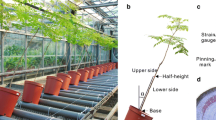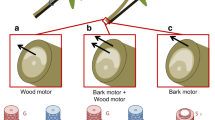Key message
With the diversified distribution of growth strain and tension wood, Koelreuteria henryi branches function in a different way from the trunk in maintaining the tree architecture.
Abstract
The tree branches, as well as trunks, function in keeping tree biomechanical equilibrium; however, researches regarding the reorientation of branches have received less attention than those of trunks. The presented paper aims to discriminate the biomechanical behavior of branches from leaning trunks. We thus investigated the development of growth strains, distribution of tension wood, and eccentricity on the branchwood of Koelreuteria henryi. The results revealed the unusual distribution of released growth strain and tension wood as well as growth eccentricity. The growth strain parameter showed seasonal changes, possibly due to the maturation of the secondary cell wall. Both the upper and the lower sides of the plagiotropic branches exhibited either contractive or extensive growth strains, whereas the orthotropic branches exhibited mostly contractive strains on the both sides, which implied different physiological functions of the two branch types. The tension wood arcs may occur in any direction of the branchwood which is different from the inclined trunk with tension wood on the upper side, suggesting dynamic adjustment in branch reorientation. In contrast to trunks, the hypotrophic eccentric growth in branches functioned in obstructing upward movement and even facilitates downward movement, probably because of the dissociation between tension wood and eccentric growth. Diversified growth strain and tension wood distribution on the branches may reflect the individual biomechanical requirements for each branch depending on the environmental factors, possibly gravitropic and phototropic stimuli.











Similar content being viewed by others
References
Alméras T, Fournier M (2009) Biomechanical design and long-term stability of trees: Morphological and wood traits involved in the balance between weight increase and the gravitropic reaction. J Theor Biol 256:370–381
Alméras T, Thibaut A, Gril J (2005) Effect of circumferential heterogeneity of wood maturation strain, modulus of elasticity and radial growth on the regulation of stem orientation in trees. Trees 19:457–467. doi:10.1007/s00468-005-0407-6
Alméras T, Derycke M, Jaouen G, Beauchene J, Fournier M (2009) Functional diversity in gravitropic reaction among tropical seedlings in relation to ecological and developmental traits. J Exp Bot 60:4397–4410. doi:10.1093/jxb/erp276
Bailleres H, Castan M, Monties B, Pollet B, Lapierre C (1997) Lignin structure in Buxus sempervirens reaction wood. Phytochemistry 44:35–39
Bastien R, Douady S, Moulia B (2014) A unifying modeling of plant shoot gravitropism with an explicit account of the effects of growth. Front Plant Sci 5:136
Clair B, Alméras T, Sugiyama J (2006a) Compression stress in opposite wood of angiosperms: observations in chestnut, mani and poplar. Ann For Sci 63:507–510. doi:10.1051/forest:2006032
Clair B, Ruelle J, Beauchêne J, Prévost MF, Fournier M (2006b) Tension wood and opposite wood in 21 tropical rain forest species 1. Occurrence and efficiency of the G-layer. IAWA 27:329–338
Coutand C, Fournier M, Moulia B (2007) The gravitropic response of poplar trunks: Key roles of prestressed wood regulation and the relative kinetics of cambial growth versus wood maturation. Plant Physiol 144:1166–1180. doi:10.1104/pp.106.088153
Coutand C, Pot G, Badel E (2014) Mechanosensing is involved in the regulation of autostress levels in tension wood. Trees 28:687–697. doi:10.1007/s00468-014-0981-6
Dassot M, Fournier M, Ningre F, Constant T (2012) Effect of tree size and competition on tension wood production over time in beech plantations and assessing relative gravitropic response with a biomechanical model. Am J Bot 99:1427–1435. doi:10.3732/ajb.1200086
Ewart AJ, Mason-Jones AJ (1906) The formation of red wood in conifers. Ann Bot 20:201–204
Fisher JB (1985) Induction of reaction wood in Terminalia (Combretaceae): roles of gravity and stress. Ann Bot 55:237–248
Fisher JB, Honda H (1979) Branch geometry and effective leaf area: a study of Terminalia-branching pattern. 1. Theoretical trees. Am J Bot 66:633–644
Fisher JB, Stevenson JW (1981) Occurrence of reaction wood in branches of dicotyledons and its role in tree architecture. Bot Gaz 142:82–95
Florida Exotic Pest Plant Council (2015) Florida Exotic Pest Plant Council’s 2015 list of invasive plant species. http://www.fleppc.org/. Accessed 24 June 2016
Fournier M, Bailleres H, Chanson B (1994) Tree biomechanics: growth, cumulative prestresses, and reorientations. Biomimetics 2:229–251
Gardiner B, Barnett J, Saranpää P, Gril J (2014) The biology of reaction wood. Springer-Verlag, Berlin Heidelberg
Huang YS, Hung LF, Kuo-Huang LL (2010) Biomechanical modeling of gravitropic response of branches: roles of asymmetric periphery growth strain versus self-weight bending effect. Trees 24:1151–1161. doi:10.1007/s00468-010-0491-0
Hung L-F, Tsai C-C, Chen S-J, Huang Y-S, Kuo-Huang L-L (2016) Study of tension wood in the artificially inclined seedlings of Koelreuteria henryi Dummer and its biomechanical function of negative gravitropism. Trees 30:609–625. doi:10.1007/s00468-015-1304-2
Höster HR, Liese W (1966) On the occurrence of reaction tissue in roots and branches of dictyledons. Holzforschung 20:80–90
Japan Material Society (1982) Dictionary of wood industry. In: Committee of Woody Material Department (ed) Wood Industry Publishers, Kyoto, p 573 (in Japanese)
Johansen DA (1940) Plant microtechnique. McGraw-Hill Book Company Inc, New York
Kučera LJ, Philipson WR (1977a) Growth eccentricity and reaction anatomy in branchwood of Drimys winteri and five native New Zealand trees. New Zeal J Bot 15:517–524
Kučera LJ, Philipson WR (1977b) Occurrence of reaction wood in some primitive dicotyledonous species. New Zeal J Bot 15:649–654
Kuo-Huang LL, Chen SS, Huang YS, Chen SJ, Hsieh YI (2007) Growth strains and related wood structures in the leaning trunks and branches of Trochodendron aralioides—a vessel-less dicotyledon. IAWA 28:211–222
Matsuzaki J, Masumori M, Tange T (2006) Stem phototropism of trees: a possible significant factor in determining stem inclination on forest slopes. Ann Bot 98:573–581. doi:10.1093/aob/mcl127
Matsuzaki J, Masumori M, Tange T (2007) Phototropic bending of non-elongating and radially growing woody stems results from asymmetrical xylem formation. Plant Cell Environ 30:646–653. doi:10.1111/j.1365-3040.2007.01656.x
Mukogawa Y, Nobuchi T, Sahri MJ (2003) Tension wood anatomy in artificially induced leaning stems of some tropical trees. For Res 75:27–33
Norberg PH, Meier H (1966) Physical and chemical properties of the gelatinous layer in tension wood fibres of aspen (Populus tremula L.). Holzforschung 20:174–178
Okuyama T, Sasaki Y, Kikata Y, Kawai N (1981) The seasonal change in growth stress in the tree trunk. J Jpn Wood Res Soc 27:350–355
Onaka F (1949) Studies on compression- and tension-wood. Mokuzai Gakkaishi 1:1–88
Patel JD, Menon ARS, Reghu CP (1984) Growth eccentricity in the branchwood of Kigella pinnata (JACQ.) DC. IAWA Bull 5:81–84
R Core Team (2013) R: a language and environment for statistical computing
Robards AW (1965) Tension wood and eccentric growth in Crack willow (Salix fragilis, L.). Ann Bot N S 29:419–431
Ruelle J, Clair B, Beauchêne J, Prévost MF, Fournier M (2006) Tension wood and opposite wood in 21 tropical rain forest species 2. Comparison of some anatomical and ultrastructural criteria. IAWA 27:341–376
Ruelle J, Yamamoto H, Thibaut B (2007a) Growth stresses and cellulose structural parameters in tension and normal wood from three tropical rainforest angiosperms species. Bioresources 2:235–251
Ruelle J, Yoshida M, Clair B, Thibaut B (2007b) Peculiar tension wood structure in Laetia procera (Poepp.) Eichl. (Flacourtiaceae). Trees 21:345–355. doi:10.1007/s00468-007-0128-0
Scurfield G (1973) Reaction wood: its structure and function: lignification may generate the force active in restoring the trunks of leaning trees to the vertical. Science 179:647–655
Sinnott EW (1952) Reaction wood and the regulation of tree Form. Am J Bot 39:69–78
Timell TE (1986) Compression wood in gymnosperms, vol II. Springer-Verlag, Berlin
Tsai CC, Hung LF, Chien CT, Chen SJ, Huang YS, Kuo-Huang LL (2012) Biomechanical features of eccentric cambial growth and reaction wood formation in broadleaf tree branches. Trees 26:1585–1595. doi:10.1007/s00468-012-0733-4
Wang Y, Gril J, Sugiyama J (2009) Variation in xylem formation of Viburnum odoratissimum var. awabuki: growth strain and related anatomical features of branches exhibiting unusual eccentric growth. Tree Physiol 29:707–713. doi:10.1093/treephys/tpp007
Wang Y, Gril J, Clair B, Minato K, Sugiyama J (2010) Wood properties and chemical composition of the eccentric growth branch of Viburnum odoratissimum var. awabuki. Trees 24:541–549. doi:10.1007/s00468-010-0425-x
Wardrop AB, Dadswell HE (1948) The nature of reaction wood. I. The structure and properties of tension wood fibres. Aust J Sci Res 1:1–16
Wardrop AB, Dadswell HE (1950) The nature of reaction wood II. The cell wall organization of compression wood tracheids. Aust J Biol Sci 3:1–13
Washusen R, Ilic J, Waugh G (2003a) The relationship between longitudinal growth strain and the occurrence of gelatinous fibers in 10 and 11-year-old Eucalyptus globulus Labill. Holz Roh Werkst 61:299–303. doi:10.1007/s00107-003-0388-3
Washusen R, Ilic J, Waugh G (2003b) The relationship between longitudinal growth strain, tree form and tension wood at the stem periphery of ten- to eleven-year-old Eucalyptus globulus Labill. Holzforschung 57:308–316
Wilson BF, Archer RR (1977) Reaction wood—induction and mechanical action. Annu Rev Plant Phys 28:23–43
Wilson BF, Archer RR (1979) Tree design: some biological solutions to mechanical problems. Bioscience 29:293–298
Yamamoto H, Abe K, Arakawa Y, Okuyama T, Gril J (2005) Role of the gelatinous layer (G-layer) on the origin of the physical properties of the tension wood of Acer sieboldianum. J Wood Sci 51:222–233. doi:10.1007/s10086-004-0639-x
Yoshida M, Nakamura T, Yamamoto H, Okuyama T (1999) Negative gravitropism and growth stress in GA(3)-treated branches of Prunus spachiana Kitamura f. spachiana cv, Plenarosea. J Wood Sci 45:368–372
Yoshida M, Okuda T, Okuyama T (2000a) Tension wood and growth stress induced by artificial inclination in Liriodendron tulipifera Linn. and Prunus spachiana Kitamura f. ascendens Kitamura. Ann For Sci 57:739–746
Yoshida M, Yamamoto H, Okuyama T (2000b) Estimating the equilibrium position by measuring growth stress in weeping branches of Prunus spachiana Kitamura f. spachiana cv. Plenarosea. J wood Sci 46:59–62
Yoshida M, Ohta H, Yamamoto H, Okuyama T (2002) Tensile growth stress and lignin distribution in the cell walls of yellow poplar, Liriodendron tulipifera Linn. Trees 16:457–464. doi:10.1007/s00468-002-0186-2
Yoshizawa N, Satoh M, Yokota S, Idei T (1993) Formation and structure of reaction wood in Buxus microphylla var. insularis Nakai. Wood Sci Technol 27:1–10
Acknowledgments
The authors would like to thank Miss Chin-Mei Lee for technical support. This study was funded by the National Science Council, Taiwan through research project NSC-97-2313-B-002-043-MY3.
Author information
Authors and Affiliations
Corresponding author
Ethics declarations
Conflict of interest
The authors declare that they have no conflict of interest.
Additional information
Communicated by T. Fourcaud.
Rights and permissions
About this article
Cite this article
Hung, LF., Tsai, CC., Chen, SJ. et al. Strain distribution, growth eccentricity, and tension wood distribution in the plagiotropic and orthotropic branches of Koelreuteria henryi Dummer. Trees 31, 149–164 (2017). https://doi.org/10.1007/s00468-016-1464-8
Received:
Accepted:
Published:
Issue Date:
DOI: https://doi.org/10.1007/s00468-016-1464-8




